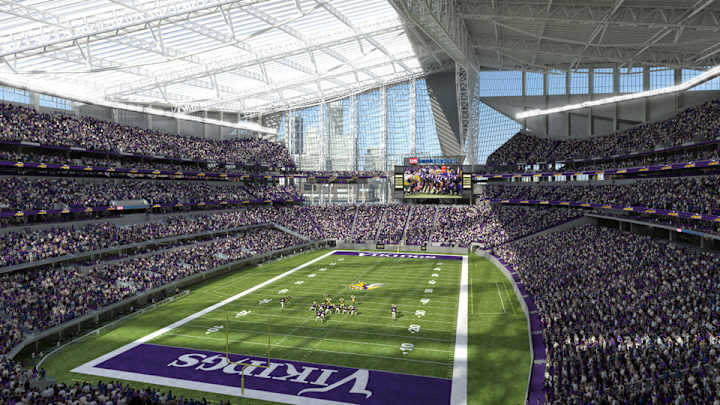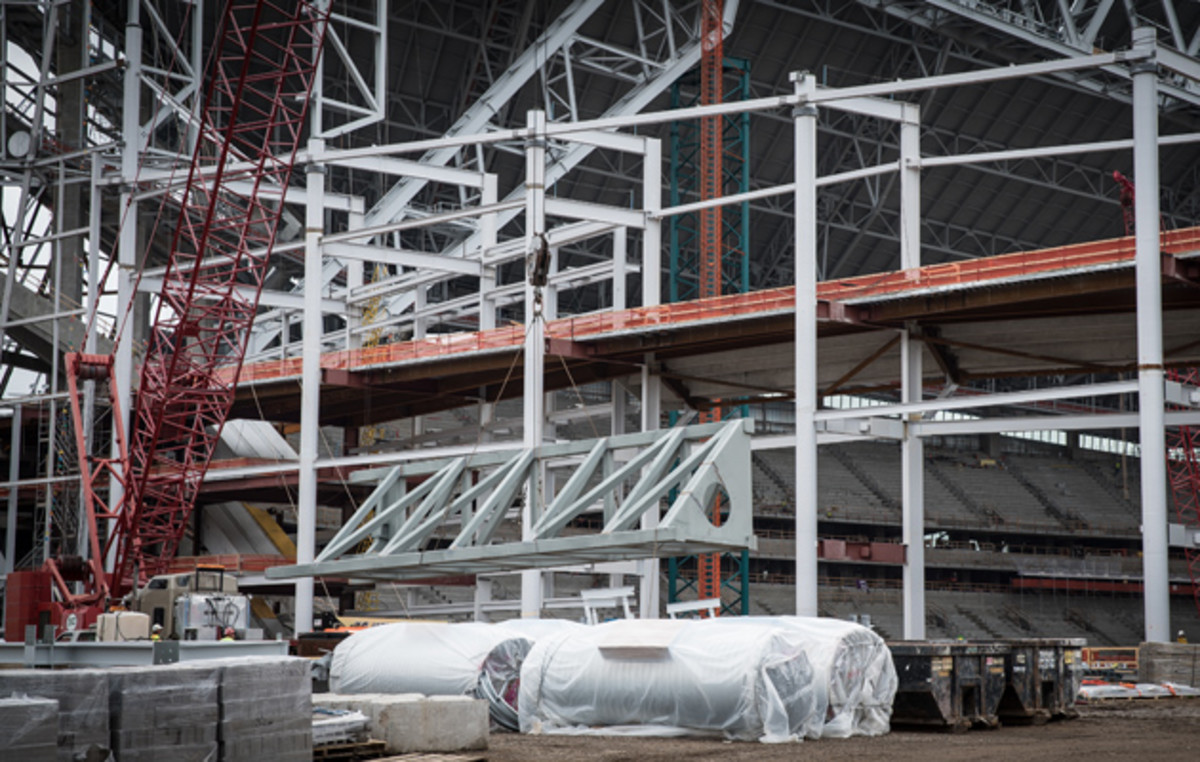U.S. Bank Stadium will bring Vikings fans close to elements, game action

Your teams. Your favorite writers. Wherever you want them. Personalize SI with our new App. Install on iOS or Android.
Closer to the field. Closer to the players. Closer to the Minnesota winter (without fear of frostbite). The brand-new U.S. Bank Stadium in Minneapolis will have it all for Vikings fans when it opens in July.
The newest NFL stadium offers over 18 different styles of seating, including suites closer to the field than any other building in the league, additional “Touchdown Suites” in the east end zone and a new class of premium general admission with dedicated concourses. And with 66,200 seats broken down into 8,000 club seats, suites and more, fans can experience it all while enjoying the lights of downtown Minneapolis from indoors.
U.S. Bank Stadium is nearly twice the size of the Metrodome, the Vikings’ previous home—twice the concourse width, twice the restroom capacity and so on. The south side of the stadium’s roof is made out of ethylene-tetraflouroethylene, or ETFE, a space-age plastic that is strong, lightweight and translucent. At 240,000 square feet, it is the largest ETFE-clad roof in North America. Combine the natural lighting from the roof with the world’s largest operable glass doors on the west end, and this indoor venue has an outdoor vibe.

Used in stadium construction around the world for about 30 years, ETFE hasn’t really taken off in North America—until now. Vikings project executive Don Becker says the stadium’s ETFE “pillows” include three layers of foil, each with a stabilizing air supply. Set inside aluminum frames and attached to the 989 foot-long steel single-ridge truss spanning the entire length of the field, the pillows also have a printed pattern that help reflect the sun. The roof’s frame is set asymmetrically to provide more coverage for the north side of the building. The ETFE pillows pair with a more traditional steel and PVC membrane roof on the north side for one of the lightest roofs in any similarly sized stadium and the world’s only superframe construction of its kind.
Vikings have laid the foundation of the NFL’s next great defense
“How do we have a unique building that fits the culture and weather in Minnesota with cold, ice and snow?” Becker says. “We wanted it to be indoors. Retractable doesn’t give you that outdoor feeling. Transparent on one side and glass on one end gave that outdoor feeling. When I walk in and see the amount of sunlight coming in, even with clouds going over, it has an outdoor feel.”
The ETFE may have another unexpected benefit: Eric Grentz, construction executive for builder Mortenson Construction, says that sound engineers believe the ETFE will reverberate noise unlike any roofing material in the league.
• FARRAR: The ideal NFL coaching staff | VRENTAS: Q&A with Kevin White

The exterior of the building resembles an A-framed ship with the prow pointing east, a distinctly Northern European design that gives Minneapolis a distinct new visual. The style also serves a purpose by helping move snow off the roof and into gutters, according to HKS architect Bryan Trubey, who designed the building. While much of the exterior features black zinc metal that will weather to gray, expect plenty of glass to go around, including at the top of the building to give the roof a floating effect. Operable doors can also let the elements in when the weather is warm enough.
The west entrance opens up onto a plaza and offers views of downtown Minneapolis from inside the building, thanks to five giant doors made of glass from Owatonna, Minn., each 55 feet wide and descending from 95 feet to 75 feet in height in alignment with the slope of the building.
The doors are the one of five entrances expected to welcome 70% of all fans on game day. The Vikings expect to leave them open for games in warmer months and close them in favor of traditional during the colder months.

The west entrance leads to the 2.7-acre plaza, which includes a 159 foot-tall Vikings ship that will serve as a photo destination for fans. The sail doubles as a video board, one of two outside the stadium walls (the other will be installed on the stadium’s exterior).
Vikings give Harrison Smith the contract to match his elite value
Beyond the plaza, a new four-acre city park connects to the stadium property, and millions of dollars worth of development surround it. The Vikings say the park will receive heavy use during major events, such as the 2018 Super Bowl and the 2019 NCAA Final Four. A brand-new sky bridge—a popular winter walkway choice in Minneapolis—connects the stadium to adjacent light rail stations, parking garages and new development.
HKS—the same firm that designed the stadiums for the Cowboys and Colts and is working on the new ETFE-heavy Inglewood project in Los Angeles. The various styles of seating within the seven-level venue include 8,000 club seats, six club lounges, eight Touchdown Suites located in the end zone and Turf Suites located at field level 25 feet from the sideline, the closest suite option at any NFL stadium. Located behind the Vikings’ sideline, the Delta Sky360 Club offers fans a glimpse of the players as they walk through for warmups before the game and at halftime.
On the west end of the stadium is the Purple Club, a fantasy football zone with couches, high-tech video walls and even an outdoor patio. There’s also a platform for the Vikings’ new Gjallarhorn—the main horn broke apart in January during the team’s bitterly cold home playoff loss to the Seahawks.

Fans enter at the main concourse level. With the field sunk 50 feet below grade, fans won’t all be going in one direction upon entry. Within a 360-degree concourse that offers near-continuous views into the playing field, fans can stay connected to the action with 2,000 television screens and two large videoboards, one at each end. Instead of choosing a giant center-hung board, the Vikings lowered the height of the boards and placed them behind the lower bowl at either end. The larger of the two, on the west end, measures 8,160 square feet, the 10th largest in the league.
Breakout players to get familiar with ahead of the 2016 season
For a local culinary tie-in, celebrity chef Andrew Zimmern will work with Aramark to put together a mix of foods that play well regionally, taking cues from the fare found at the Minnesota State Fair. On top of that, expect fun Minneapolis favorites such as the Juicy Lucy stuffed burger.
A publicly owned facility, U.S. Bank Stadium was designed to host soccer, concerts, trade shows and more events, including baseball games, a capability made possible by a robust 32-row retractable seating design on the north side.
Fans will stay protected from the elements and close to the action every step of the way as the Vikings players leave their locker room—with lockers made of stone—and hit the turf.
What excites Vikings chief operating officer Kevin Warren most about the new venue is all the lasting memories and stories that will happen within it. “We’ve created a building and atmosphere that will create memories that will last forever,” he says.
Tim Newcomb covers stadiums, sneakers and technology for Sports Illustrated. Follow him on Twitter at @tdnewcomb.
